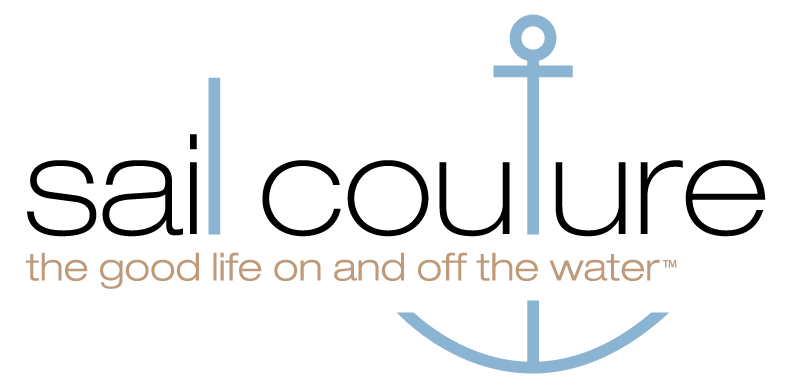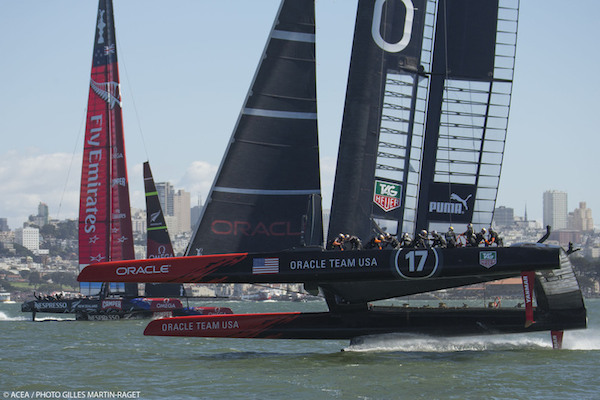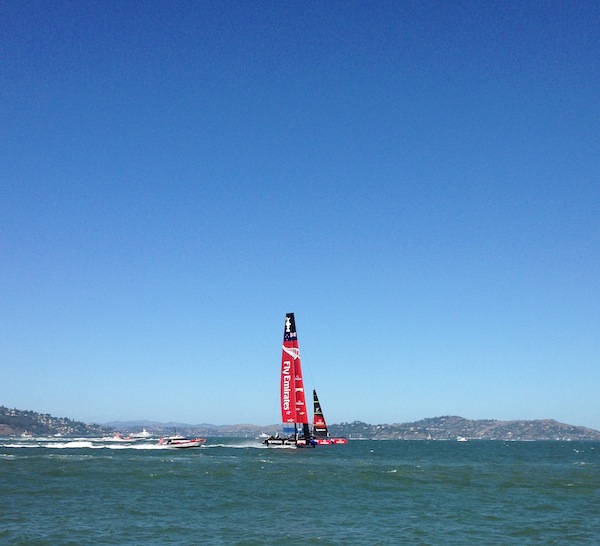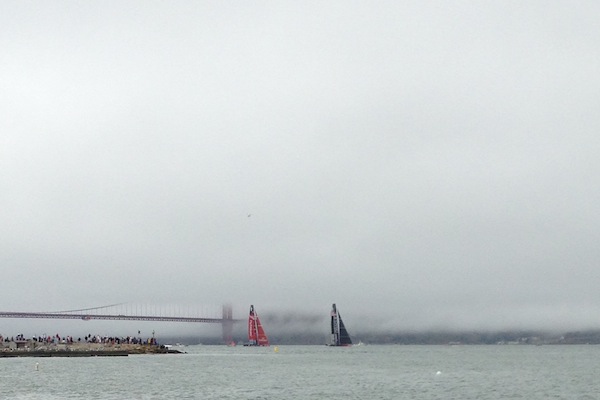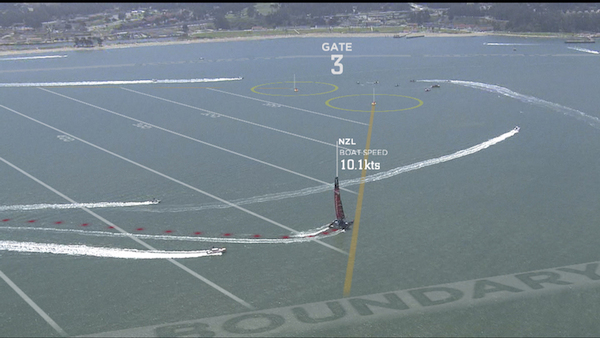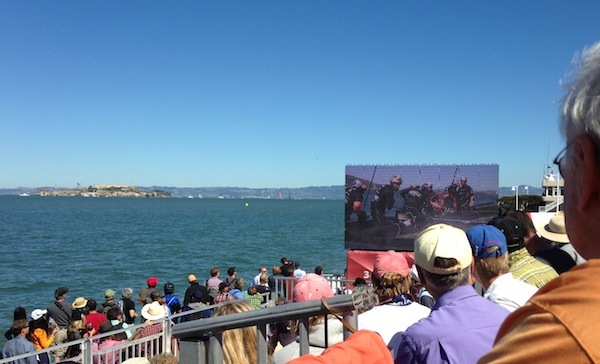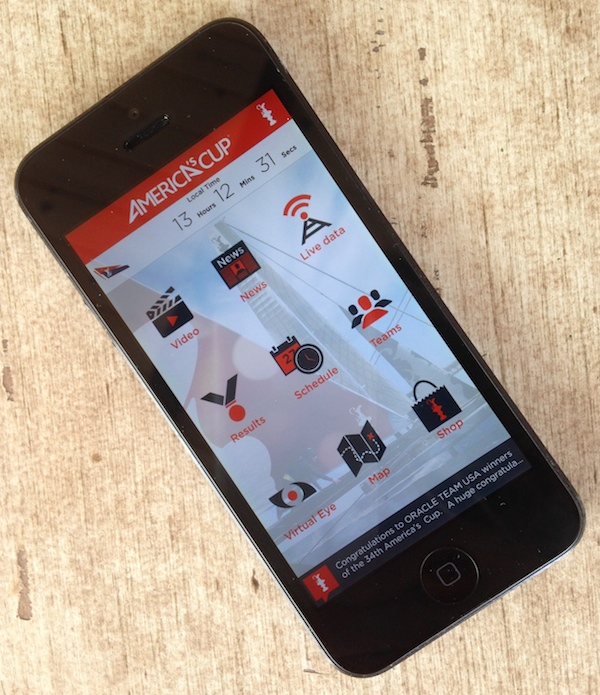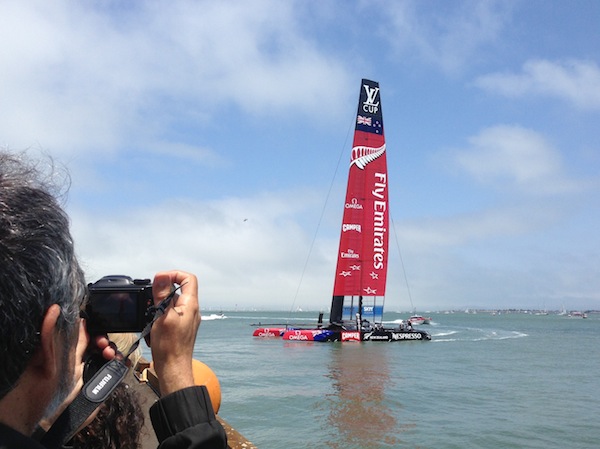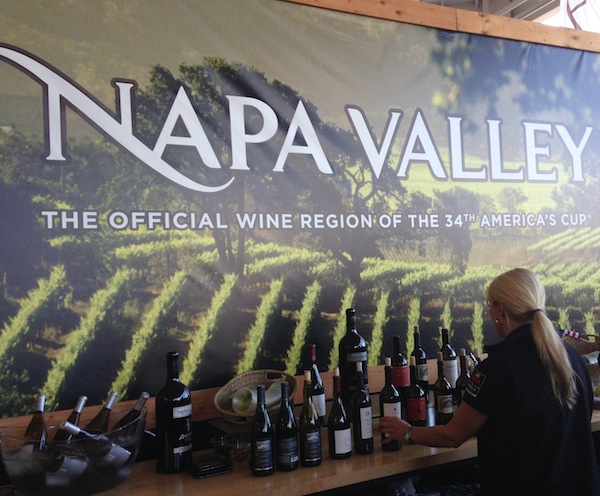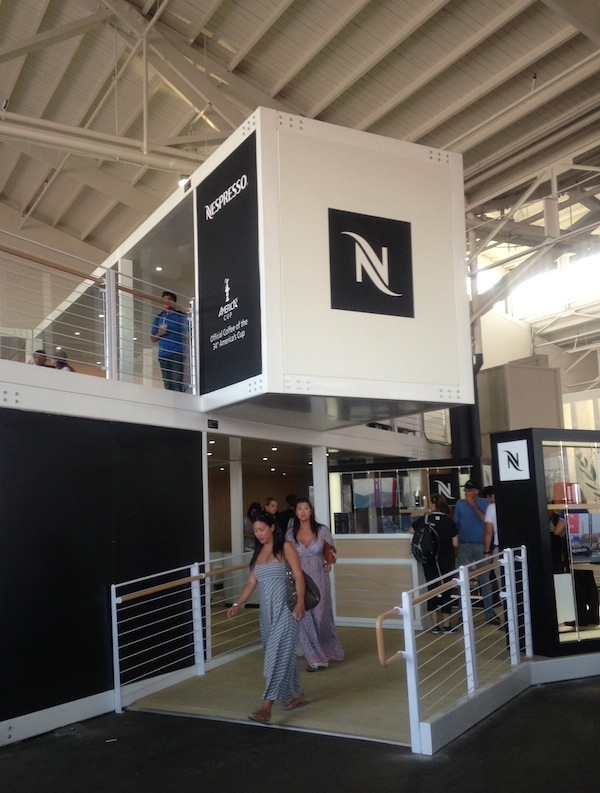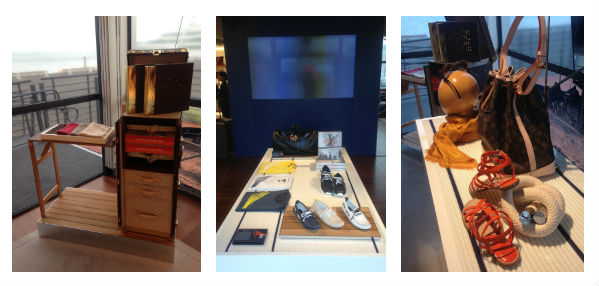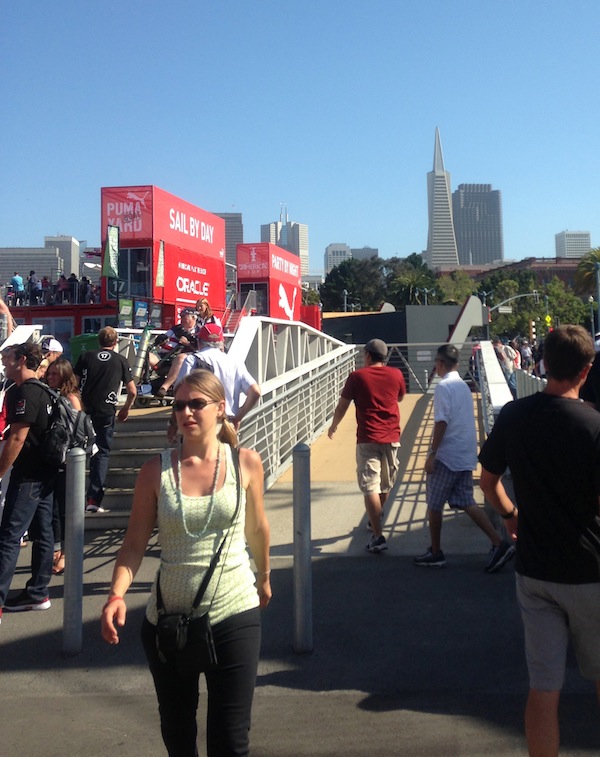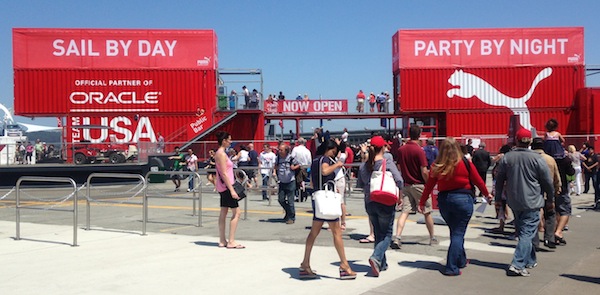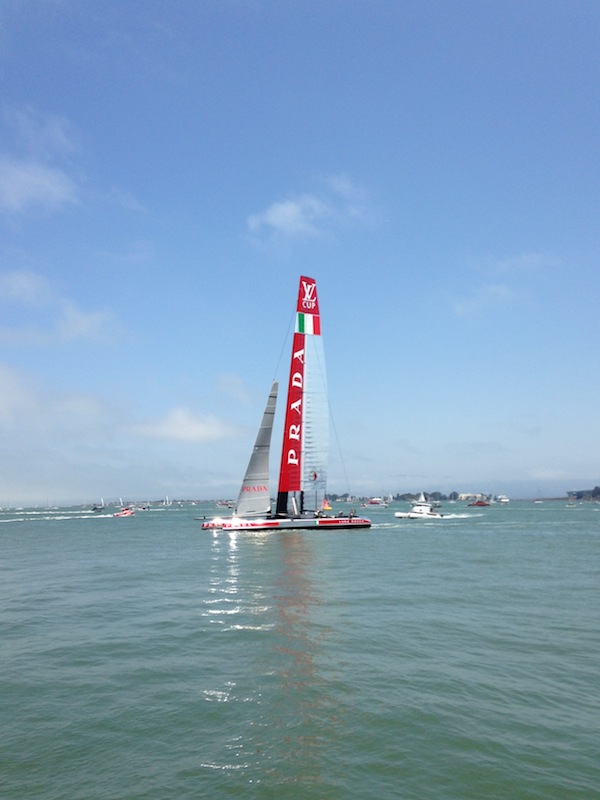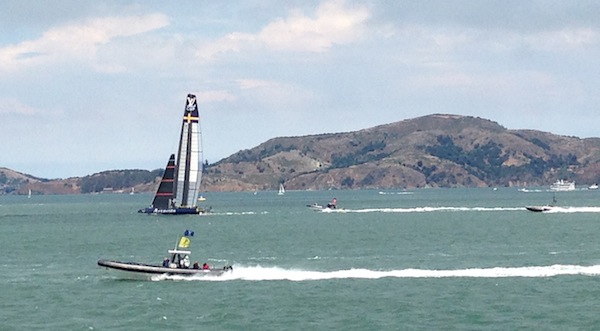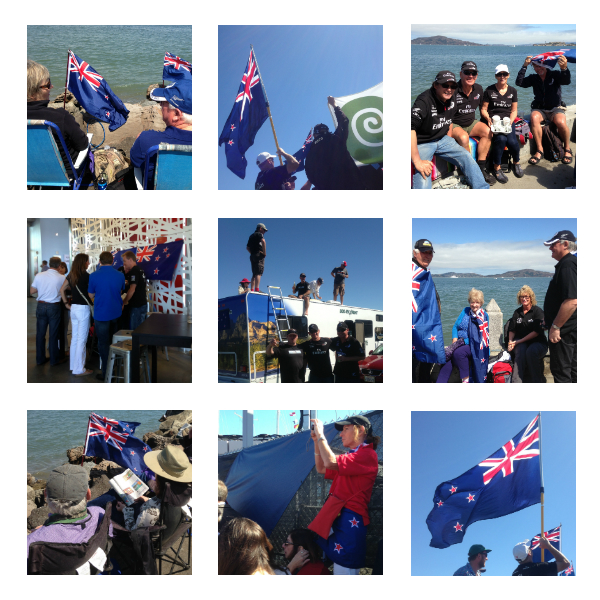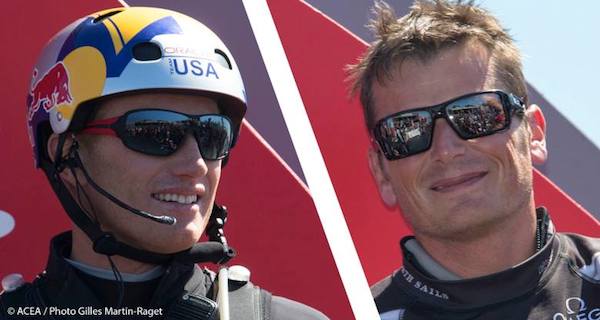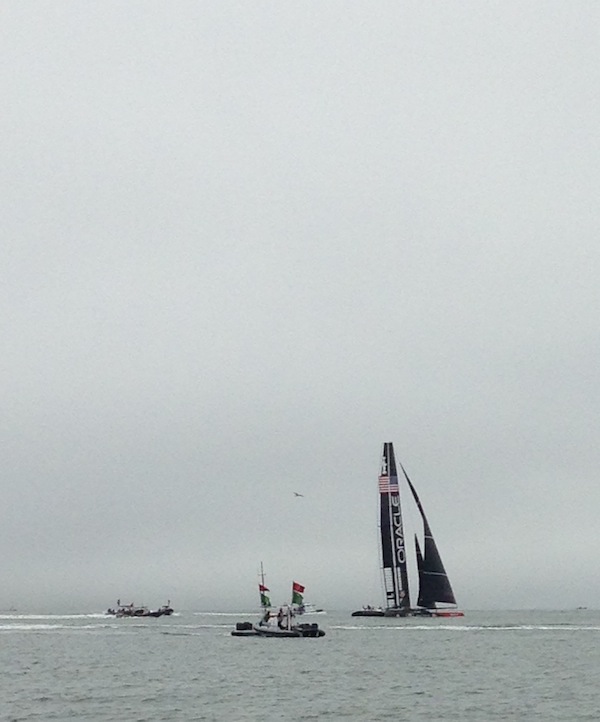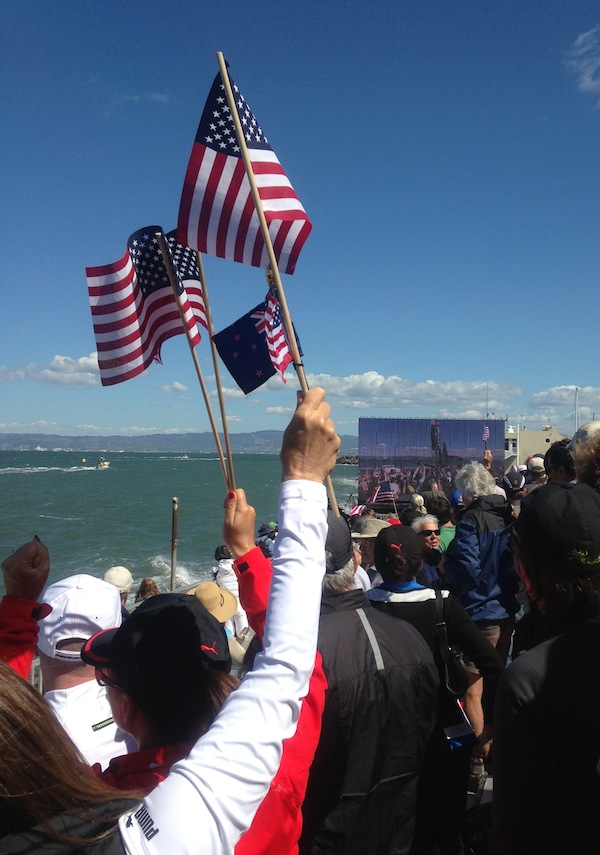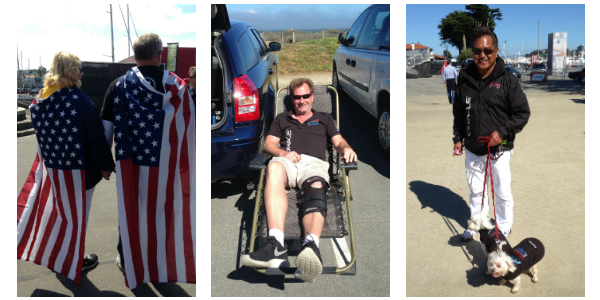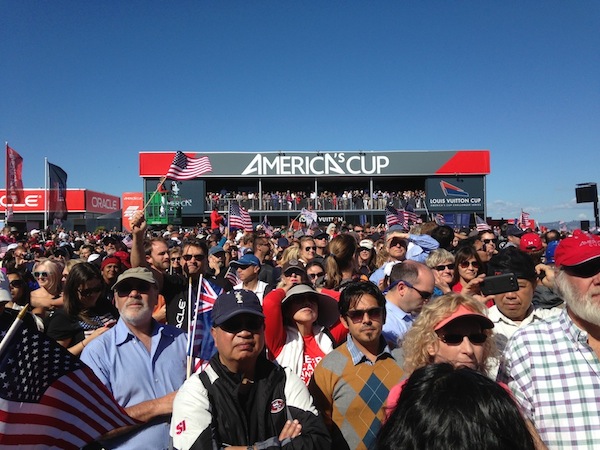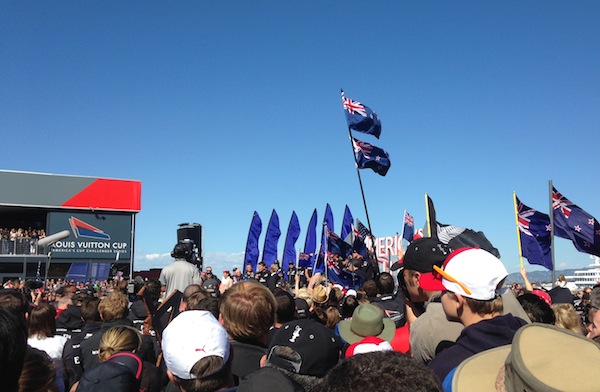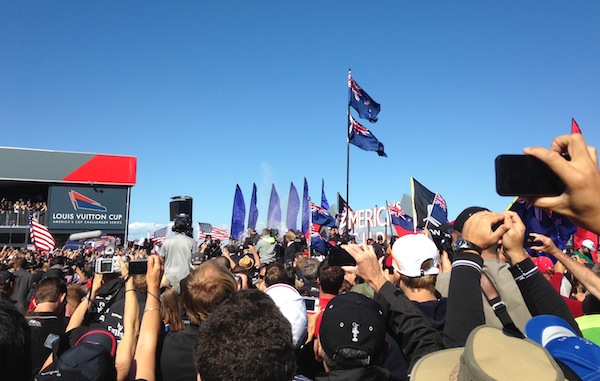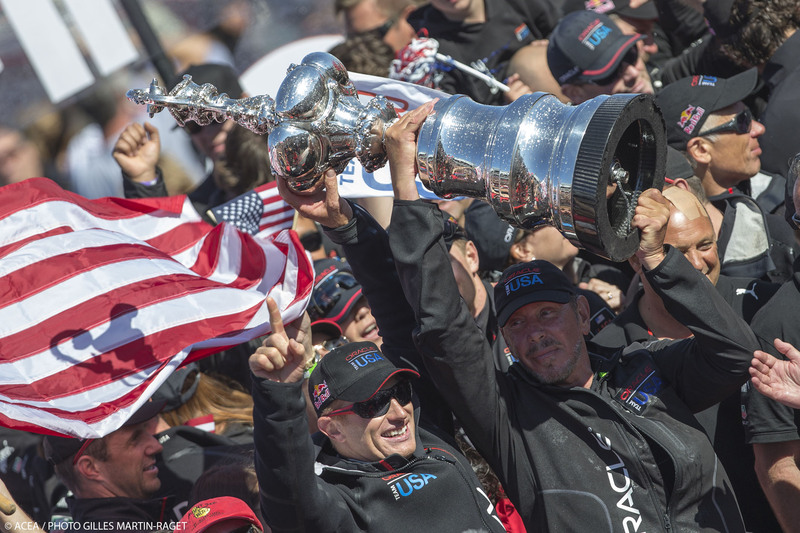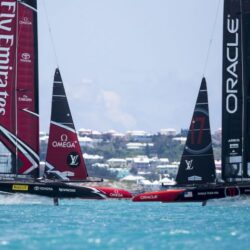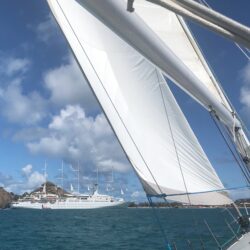The 34th America’s Cup had a little something for everyone: the world’s best sailors, incredibly fast boats, achingly beautiful vistas, cutting-edge technology both on and off the water, controversy and of course the most dramatic come from behind victory in sports history.
Many initially questioned Larry Ellison and Russell Coutts’ grand plan to redefine professional sailing and attract a younger sports-minded sailing audience. The America’s Cup is the oldest trophy in international sport after all.
Their new AC72s, able to “fly” above the water and travel faster than the wind – capable of achieving speeds of speeds of 45 knots/50 mph – were quite a departure from our fathers’ AC. The demands of racing an AC72 created a new breed of AC sailor, a serious extreme athlete who constantly pushed the limit. Sailors who wore crash helmets and high-tech fabric more often than blue blazers.
oracle team usa in their crash helmets and high-tech uniforms – photo: guilian grenier, courtesy of the america’s cup event authority
It was a rather inauspicious start.
We wouldn’t have an America’s Cup without some controversy but for AC34 it extended far beyond the sailing community. Host city San Francisco’s residents seemed evenly divided on the cup, many believing it benefited only the rich. Rather than focusing on the teams competing, they tended to focus on the billionaire syndicate owners. Forgetting that our baseball and football team owners are also quite wealthy. There were op-eds and protests to having the cup here at all. Fortunately for us all, there were equal numbers of residents who saw the value in hosting this world-class sporting event who were equally as vocal.
Within the sailing camps, some felt the tech envelope had been pushed too far with state-of-the-art catamarans with “wings” which have more in common with an airplane’s wing than a traditional sail. There were numerous calls to return to classic monohulls. Given my love for all things classic, I guess it’s not too surprising early on I was sympathetic to this view. Like so many others however, overtime I was won over by the speed and agility of these technological marvels.
Once you’ve experienced the thrill of seeing the AC72s screaming around the course at 45+ knots, it’s hard to go back… Expectations have to be adjusted.
The Rolex Big Boat Series followed the AC in San Francisco, and after the AC these very beautiful and fast boats seemed to be positively crawling around the course. I have no doubt before long their boat speed again will be the norm for me, but for now ah, AC34 and your Summer of Racing how you have spoiled me.
The one thing even more exciting than AC boats was the sailors who tamed them – the crème de la crème of the sailing world: Jimmy Spithill, Dean Barker, Nathan Outteridge, Chris Draper, Loick Peyron… It reads like a who’s who of racing. How thrilling it was to watch these modern day gladiators do battle on San Francisco Bay. The strategy, the finesse, the leadership these titans showcased was nothing less than mesmerizing.
Equally impressive was the humility of these sailing rockstars. In a sport known for egos it was gratifying to see how they always took time chat with fans.
San Francisco’s natural sailing amphitheater and beauty made it an ideal location. Watching the races from the AC Village on the Marina Green was amazing. How thrilling to watch the action live as it unfolded in front of you and then with a slight tilt of the head, see the LiveLine graphics and commentary on the big screen. Much has been made of the LiveLine graphics and rightly so. Stan Honey, who pioneered the original virtual yellow 1st & Ten line for football, devised a new technological breakthrough involving three helicopters for AC34. His goal was not only to provide more technical information for serious sailors, but also to make the sport more accessible to new fans. Even for the initiated, sailing racing can be a bit challenging to follow at times even given helicopter camera angles, and LiveLine made it much easier to grasp who was ahead, behind and by how far.
It was great having LiveLine on the big screen next to the stands. The resolution actually was quite good, my IPhone photo didn’t capture it for some reason.
The cameras aboard the boats were another stroke of genius. It was almost like being there… How very cool to see the action onboard, witnessing the teamwork up close and the priceless expressions of the sailors as the days racing unfolded. The coverage was excellent, I really didn’t mind watching on the computer when I couldn’t be there in person. Often when I did attend the race, I watched the race again later in the evening. The coverage was that good. I especially enjoyed the commentary of Ken Read and Gary Jobson. Andy Green’s color commentary before and after was entertaining and appreciated.
Another brilliant addition was the AC34 app, an amazing mobile resource for smartphones with real time video, news, results, schedule and “virtual eye” – a graphic view of the race with technical data.
Equally fun, but in a different way was the experience at AC Park on Pier 27. Although only the finish was visible from this location, you needed to watch the majority of the race on the big screen tv’s there, it was spectacular to see the teams do a close fly by after the races. Before and after the races there were interesting happenings and events, fun pavilions to enjoy, my favorites were the Napa Vintners and Nespresso.
As a passionate wine person, I was pleased by the variety and caliber of wine available at the Napa Vintners Pavilion. I was happy to see so many of my favored wineries there: Stags Leap, Cakebread, Artesa, Newton and Clos Pegase to name a few. It became my meetup spot there, although the Mumm Pavilion was quite nice as well.
I really liked that Nespresso had a nice pavilion at both the AC Park and Village, while the Napa Vintners had only an information booth at the Village. I missed the wine and champagne tents on the Marina Green so popular last year during the AC World Series.
AC34 had some nice shopping options, from the exquisite items at the Louis Vuitton boutique, home to the special edition San Francisco Neverfull tote to the more across the board America’s Cup Store. I was impressed how the America’s Cup Store made sustainability a focus for some of their licensed products. The polos I bought were made from six plastic bottles that otherwise would have ended up in landfills or our oceans. I felt doubly good about that purchase.
The Puma Store at AC Park doubled as a bar, shopping below and drinks and DJ atop in the Puma Yard. Their slogan was “sail by day, party by night” – to which I totally ascribe!
Like many epic sporting stories, the story of AC34 has had many twists and turns. Early on the tragic death of Artemis sailor Andrew “Bart” Simpson and the total destruction of their AC72 in a training accident set a pallor over the event. The outpouring of love and support by the world for the talented Olympic sailor was moving, as was the resolve of his teammates to continue on as tribute.
Everyone knew the Louis Vuitton Cup was sure to be a different event with Artemis sidelined as their second AC72 was not ready yet, we just didn’t know how different… It quickly became apparent the other two teams, Emirates Team New Zealand and Luna Rossa were hopelessly mismatched even though they had been training partners.
ETNZ was sailing perfection, functioning as a single well-oiled machine. Poetry in motion some called it and I agree. In comparison Luna Rossa looked more like club racers out for the weekend. Given the disparity, it was almost painful to watch when they raced together. The onboard cameras only highlighted difference in teamwork.
Round robin rules required both teams to race alone on the days they were matched with Artemis. On the days ETNZ sailed I eagerly watched their master class in sailing. On Luna Rossa days I admired the beauty of the boat. It was stunning. It was splendid when the light shined a certain way and the hauls gleamed in the sun. Their catamaran was gorgeous, a tribute Italian style and befitting the House of Prada. I remember thinking, “Oh Luna Rossa, why can’t you be as fast you are beautiful,” for it wasn’t just a matter of crew work. Luna Rossa had built only one AC72 so their boat was not as technologically advanced as ETNZ’s.
Once Artemis was finally ready, we all held our breath. The team faced many challenges… A second generation of a less than inspired boat design and less practice time on the water than any other team and the emotional toll of the loss of a beloved team member. Sadly, the amazing comeback we all had dared hope for didn’t materialize, ENTZ easily won the Louis Vuitton Cup and rightly so.
I do wonder what might have been with Artemis, given the amount of star power on that boat. Local hero Paul Cayard, Nathan Outteridge who so skillfully handled Team Korea in the AC World Series and then was quickly hired away by owner Torbjorn Tornqvist and later the addition of Loick Peyron, French multihull sailing legend. It’s said that in the America’s Cup it all comes down to the fastest boat. In that case, Artemis surely would not have won for the conventional wisdom was theirs was the slowest of the fleet. I guess that is one reason why I like one design racing so much.
Hungry for a real sailboat race after the LVC debacle, we were rewarded, but not before there was more drama than just about anyone could have imagined. Initially it seemed we were in for a repeat performance of the LV Cup, the Kiwi’s fast boat and superior crew work making for a short series. It seemed all but inevitable ETNZ would win, momentum was on their side and there was energy in the air. Enthusiastic Kiwi fans were everywhere, nearly taking over one of the Q&A sessions following the races at the AC Village one day.
jimmy spithill and dean barker – photo: gilles martin-raget, courtesy of the america’s cup event authority
What impressed me most during this period was the mixture of determination and grace of Dean Barker. Easily having the faster boat and out maneuvering OTUSA on just about every occasion, Barker always displayed the highest caliber of professionalism and sportsmanship. How easy it would have been to let ego creep in, to answer one of the many questions about how they would be handle the Cup next. He always resisted, focusing only on his current inspired campaign.
Witnessing first-hand the passion and dedication not only ETNZ but also their legion of fans who traveled around the world to support their team, I began to wonder if the Cup didn’t really belong there. Few Americas were sporting team attire or really even cheering in the stands. Though I guess at that point there wasn’t much to cheer about.
I’d always been a bit conflicted about which team to support in the AC, OTUSA was of course the home team, but how home was it if only one sailor was American? New Zealand had basically fielded a nationalistic team – and it was the only one not funded by a billionaire. Everyone loves an underdog and I think I also liked the idea of a David beating Goliath. There was the recent revelation of cheating on the behalf of some of the OTUSA team members in the AC World Series… Subsequently, OTUSA began AC34 with loss of personnel and a two race deficit as directed by the international jury.
Suddenly with ETNZ at match point, I began to see things differently, now OTUSA as the underdog. Jimmy Spithill said as much in a press conference, which he handled as skillfully as a sailboat. When asked if he realistically could see OTUSA back in contention, he brilliantly turned the pressure to perform on Barker, whose fellow countrymen were already making plans for AC35.
“I think the question is what if these guys lost from here,” he said. “What an upset that would be, I mean they almost have it in the bag. That’s my motivation. It would be one hell of a comeback and that’s the kind of thing I’d like to be a part of.” Spithill’s psychological warfare proved he is a fierce competitor both on and off the course.
What happened next everyone knows. It’s the stuff books are written about and movies are made.
During OTUSA’s amazing comeback – faced with elimination and then winning eight straight races – I cheered along with my fellow Americans. It was thrilling to be there and to witness history being made. The energy was off the hook and the dramatic turn of events had inspired so many, for the first time I saw as many team jerseys on Americans as Kiwis.
Throughout that final winner take all race I knew in my heart I would be OK with either outcome. OTUSA won of course, and I applaud their tenacity – those all-important last minute tweaks to their boat and their much improved teamwork. The afterguard of Spithill, Ainsley and Slingsby was a real winning combination, on top of the resilient shore team that in the eleventh hour gave them a boat they could win with.
AC Park was electric for the trophy ceremony. Sailing fans from all over crowded onto Pier 27 before people were turned away due to the sheer numbers.
There I was again struck by the sportsmanship of the Kiwis. They had come so very close, had the wind gods co-operated eight races ago they would have won. However, the winds proved too light that day and their commanding win did not count as the race was timed out. Thus Mother Nature giving the Americans the opportunity to make their remarkable comeback. Barker and crew again displayed their signature grace in defeat. I couldn’t help but wish there could have been two trophies handed out.
Soon it was time for the Cup presentation and how inspiring it was to be there and share in the joy of OTUSA. With their dramatic come from behind win, you couldn’t help but feel it was a Mumm moment for all of us.
In the end, I think AC34 was as much of a come from behind victory for Ellison and Coutts’ vision for the 34th AC as it was for the team. AC34 was watched by more people than any America’s Cup in history. It was without a doubt the most exciting sailing racing I’ve experienced, a feeling echoed by many more astute than I. Friends who were never interested in sailing now are. The naysayers have been silenced.
Cheers to AC34, I cannot await for AC35!
